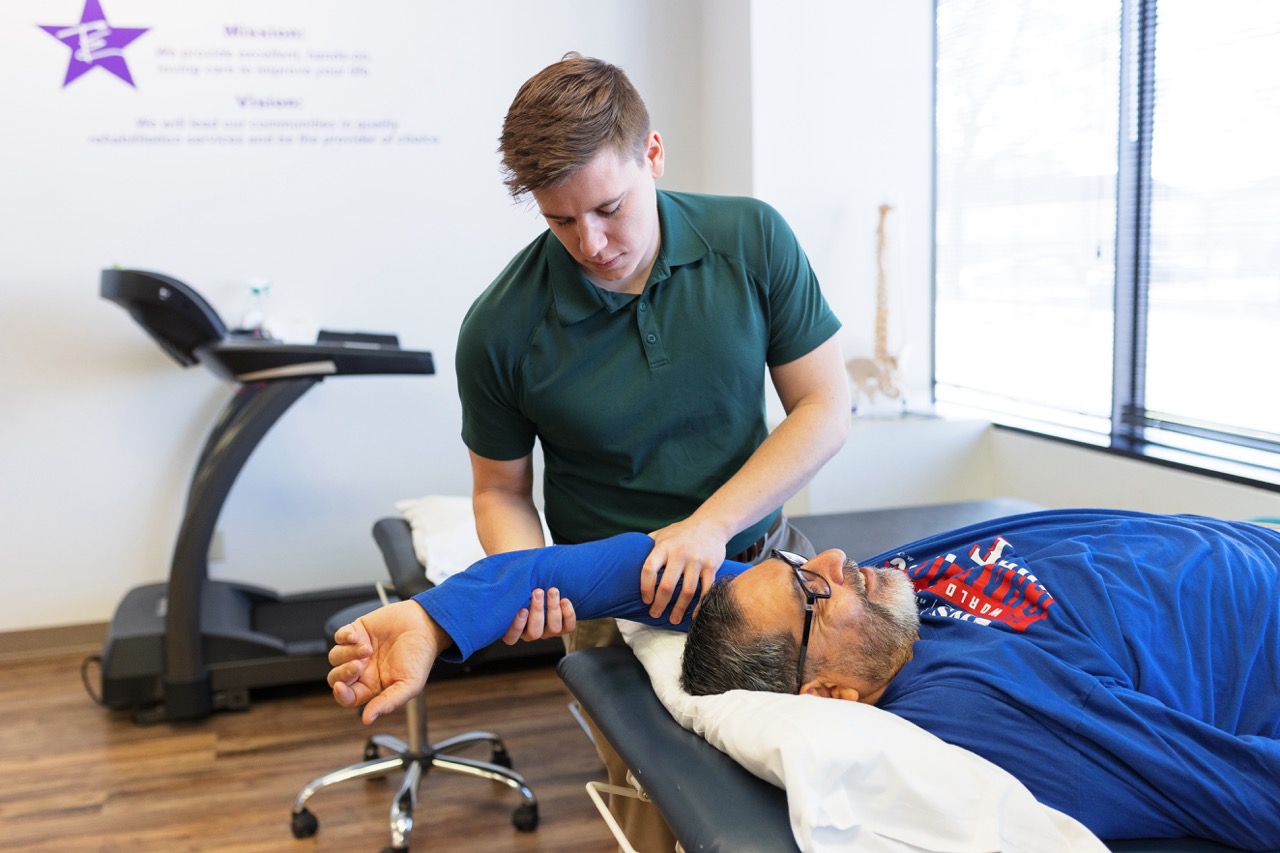Improving Mobility and Flexibility with Physical Therapy

When it comes to maintaining an active and pain-free lifestyle, good mobility and flexibility are important. Whether you're recovering from an injury, dealing with chronic pain, or just aiming to improve your overall movement quality, physical therapy can be an invaluable tool. Through specific exercises, techniques, and routines, physical therapists can help you improve joint mobility and flexibility, which can significantly enhance your quality of life. In this blog post, we’ll explore how physical therapy can improve your mobility, explain the long-term benefits of maintaining a healthy range of motion, and provide a set of example exercises that may help improve your mobility and flexibility.
What is Mobility and Flexibility?
Mobility refers to the ability of a joint to move freely through its full range of motion. It encompasses the function of muscles, tendons, and ligaments that work together to allow smooth, controlled movement. Flexibility, on the other hand, refers to the length and elasticity of muscles and soft tissues that enable them to stretch comfortably. Having both good mobility and flexibility can help improve overall physical function.
How Physical Therapy Improves Mobility and Flexibility
Physical therapy is designed to treat and manage a variety of conditions, including those that limit joint mobility and flexibility. A physical therapist (PT) conducts thorough assessments to identify restrictions and develops personalized treatment plans. These plans often include:
- Stretching and Flexibility Exercises: Tailored to target specific muscle groups, these exercises help increase tissue length and flexibility.
- Strengthening Exercises: It is important to note that we should not solely stretch our muscles, but we also need to strengthen throughout our range of motion. This ensures that our muscles can support our joints throughout their motion and improves the efficiency of our day to day activities.
- Postural Education: Teaching proper alignment and body mechanics reduces stress on joints and muscles, contributing to better mobility.
Exercises and Routines to Enhance Joint Mobility and Flexibility
- Hip Flexor Stretch (for hip flexor flexibility):
- How to do it: Step into a lunge position, ensuring your front knee is directly over your ankle. Keep your back knee on the floor and gently push your hips forward.
- Hold for: 30-45 seconds on each leg. Complete 3 repetitions on each leg.
- Benefits: This exercise primarily stretches the hip flexors and helps improve hip mobility, which is vital for walking, squatting, and other daily activities.
- Trunk Rotation (for spinal mobility):
- How to do it: Sit tall on a chair with your feet flat on the ground. Place your hands behind your head. Slowly rotate your upper body to one side, keeping your lower body stable.
- Hold for: 3-5 seconds per side and repeat 10 times.
- Benefits: This exercise targets the spine, improving flexibility and range of motion in the upper back, which can reduce stiffness.
- Supine Hamstring Stretch with Strap (for lower body flexibility):
- How to do it: Lie on your back with your legs extended straight on the floor. Loop a strap, belt, or towel around the ball of the foot of one of your feet. Hold the strap with both hands and gently pull your leg towards you while keeping the knee straight. Make sure to keep your hips flat on the ground and your lower back pressed against the floor. Hold the stretch when you feel a gentle pull along the back of your leg.
- Hold for: 30-45 seconds on each leg. Complete 3 repetitions on each leg.
- Benefits: Stretching the hamstrings enhances the flexibility of the posterior chain and helps with movements like bending, squatting, and walking.
- Kneeling Ankle Dorsiflexion Mobility with Wall (for ankle flexibility and range of motion):
- How to do it: Start by kneeling on the floor with one knee on the ground and the other foot placed in front of you, forming a 90-degree angle at the knee. Position your front foot a few inches away from a wall. Gently lean forward, aiming to touch your knee to the wall while keeping your heel on the floor. Maintain an upright torso throughout the movement and ensure your foot remains flat on the ground. Hold for 10 seconds, then return to the starting position.
- Hold for: Repeat 10-15 times per leg.
- Benefits: This exercise increases ankle dorsiflexion by improving the range of motion in the ankle joint, especially in the lower legs ability to move forward. It's particularly beneficial for improving mobility for activities such as squatting, lunging, and running. It also helps reduce ankle stiffness and tightness in the calf muscles.
5. Cat-Cow Stretch (for spinal mobility):
- How to do it: Start on all fours. Arch your back toward the ceiling (cat pose) and then lower your belly toward the floor as you look slightly upward (cow pose).
- Repeat: 10-15 times.
- Benefits: This stretch improves the mobility of the spine, particularly in the lumbar and thoracic regions, and helps with alleviating back tension.
The Benefits of Maintaining Good Range of Motion
Maintaining good range of motion in your joints offers a range of long-term health benefits:
- Improved Movement Quality: When joints can move freely, it encourages optimal movement patterns and improves ease of movement during your daily activities. This can improve your walking, running, sitting, and even your ability to perform exercises without pain or discomfort.
- Reduced Muscle Tension: Regularly stretching and improving joint mobility can help alleviate sensations of muscle tightness. This is particularly important for individuals with sedentary jobs or those who spend long hours sitting, as stiffness and discomfort often arise in the neck, back, and hips.
- Enhanced Athletic Performance: Athletes, in particular, benefit from good mobility. Flexibility and joint mobility improve the efficiency and fluidity of movements, such as running, jumping, or lifting. Greater range of motion in the hips, shoulders, and knees can lead to better performance.
- Pain Relief: Chronic pain and conditions like arthritis can limit range of motion and create stiffness. Physical therapy can help reduce this discomfort by targeting the underlying issues, improving flexibility, and strengthening the muscles that support the joints.
- Increased Independence: Maintaining mobility and flexibility allows you to perform daily tasks with ease, particularly as you age. From climbing stairs to carrying groceries, a full range of motion helps keep you independent and active throughout life.
Conclusion
Improving joint mobility and flexibility with physical therapy is an essential part of maintaining an active and healthy lifestyle. By incorporating individually targeted exercises and routines, you can improve your range of motion, reduce pain, and improve your daily function. Whether you're recovering from an injury, managing chronic pain, or simply looking to enhance your overall physical function, physical therapy offers a personalized approach to help you achieve your goals.
Remember, it’s important to consult with a physical therapist to create a customized plan tailored to your individual needs and to ensure you're practicing exercises safely. With consistency and dedication, you’ll be well on your way to enjoying improved mobility and flexibility—helping you move better, feel better, and live better!
Resources:
Afonso, J., Ramirez-Campillo, R., Moscão, J., Rocha, T., Zacca, R., Martins, A., Milheiro, A. A., Ferreira, J., Sarmento, H., & Clemente, F. M. (2021). Strength Training versus Stretching for Improving Range of Motion: A Systematic Review and Meta-Analysis. Healthcare, 9(4), 427. https://doi.org/10.3390/healthcare9040427
Konrad, A., Alizadeh, S., Daneshjoo, A., Anvar, S. H., Graham, A., Zahiri, A., Goudini, R., Edwards, C., Scharf, C., & Behm, D. G. (2023). Chronic effects of stretching on range of motion with consideration of potential moderating variables: A systematic review with meta-analysis. Journal of Sport and Health Science/Journal of Sport and Health Science, 13(2), 186–194. https://doi.org/10.1016/j.jshs.2023.06.002
Thomas, Ewan, et al. “The relation between stretching typology and stretching duration: The effects on range of motion.” International Journal of Sports Medicine, vol. 39, no. 04, 5 Mar. 2018, pp. 243–254, https://doi.org/10.1055/s-0044-101146.
Stathokostas, L., Little, R. M. D., Vandervoort, A. A., & Paterson, D. H. (2012). Flexibility Training and Functional Ability in Older Adults: A Systematic review. Journal of Aging Research, 2012, 1–30. https://doi.org/10.1155/2012/306818

Serving the DFW with Five Locations
At Therapy Excellence, our five clinic locations across the Dallas-Fort Worth region embody our commitment to personalized, hands-on care. Each center is staffed by highly qualified therapists specializing in manual therapy techniques, ensuring every patient receives exceptional, tailored rehabilitation services that set the benchmark for physical therapy in DFW.
Make An Appointment

